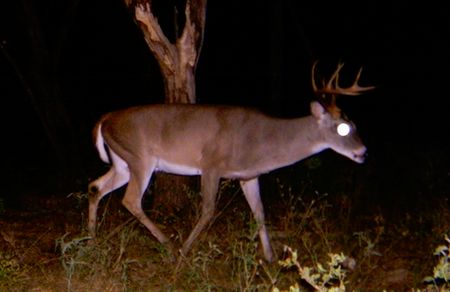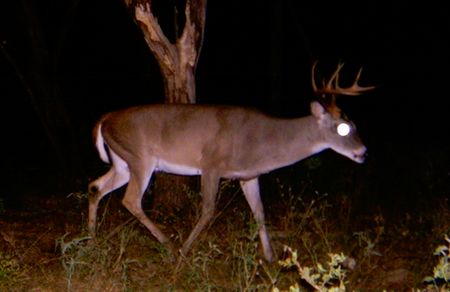The importance of estimating a white-tailed deer herd on an annual basis is critical to any ranch interested in deer management. And although several survey types (methods) should be combined to get the most accurate deer population estimate, I prefer to use spotlight surveys to estimate the deer density on any given ranch. With that said, deer spotlight surveys on properties less than 400 acres in size become less reliable. The smaller the ranch, the more I shy away from using spotlight routes. This is not necessarily because the methodology is bad, but because smaller ranches have fewer roads. Fewer roads equates to shorter spotlight survey routes and data that is less reliable.
But it can get even worse, especially if a property owner tries to create more survey length by looping around in a smaller area. Surveying smaller properties increases the potential of counting deer in one area, then looping around and counting them again in another area. To accurately estimate deer density on any ranch, animals can not be repeatedly counted along the route. I refer to the importance of maintaining and recording data on individual deer herds all of the time, but I’ve never mentioned exactly how a spotlight survey should be conducted. We are going to fix that today. If you are interested in getting the best white-tailed deer density estimate possible, then this is how a spotlight survey should be performed.
Set Up the Best Deer Survey Route Possible
First, rarely is it possible to survey a ranch perfectly. A perfect spotlight route would go through the wooded and open portions of a property at proportion which those areas occur on the ranch. This rarely happens because surveys are usually restricted to the roadways that exists on the property. I recommend getting an aerial photo as a map, highlighting the roads, and then determining the best possible route. By looking at the map you can determine the longest (and/or best) route possible using the available roads, but you can also readily see potential problems. Keep in mind that you do not have to use all roadways.
Avoid areas where you may re-count deer, such as driving tight loops or driving along narrow, wooded areas where you count deer on one side and then eventually drive around the other side and count them again. Do your best to cover the ranch as thoroughly as possible, and do not go out of your way to drive by every single feeder or food plot. A big assumption of the spotlight survey is that deer are evenly distributed on the property, so do not bait the line in an attempt to attract deer for counting. This will cause an over-estimate.
Determine the Acreage Surveyed
Surveying whitetail is fun, and yearly counts can give you trend information about the deer herd, but without determining the amount of acreage surveyed, it is impossible to estimate the number of deer on your ranch. It is not difficult to calculate the acreage surveyed, but you should do this prior to conducting the survey. To do this, go to the starting point of the route and set your trip meter to zero. Record the distance, in yards, up to 300 yards, that you can see a deer to the left and to the right. This is typically the distance to the brush or tree line, but also take grass taller than 3 1/2 feet high into account. Next, drive one-tenth (1/10) of a mile and record the distance that you can see, on average, to the left and to the right again. Do this every one-tenth of a mile until you get to the end, and take the distances there, too. Record the length of the route.
It is now possible to calculate the area surveyed because we know the length of the line and the width of the survey route was recorded every one-tenth of a mile. We are going to go through an example now, so hold on. Let’s say the spotlight route is 2.0 miles in length. Left and right distances would be recorded at the starting point and then to the left and right every one-tenth of a mile for 2.0 miles. This would result in 21 distances to the left and 21 distances to the right. Add all 42 of these numbers together and divide by 21. This will give you the average width (W) of the survey route, in yards.
Next, multiply the length of the route in miles by 1,760 to convert the length to yards. In this case, it would be 2.0 miles x 1,760 yards for a length (L) of 3,520 yards. Now, let’s say the average width (W) is 75 yards. Using the formula Area (A) = L x W, then 3,520 yards (L) x 75 yards (W) would be 264,000 square yards (A). And since there are 4,840 square yards in an acre, if we divide 264,000 by 4,840 then we find that the survey actually covered 54.5 acres. Here comes the cool part. If 8 deer are counted on the survey, then the deer density is 1 deer for every 6.8 acres (54.5 acres/8 deer). If the entire ranch is 500 acres, then 500/6.8 acres per deer means the property has an estimated deer population of about 73 deer.
Conduct the Deer Survey at the Right Time
The best time to count deer is in late summer and early fall. At southern latitudes, say from Texas across the Southeastern United States, August through early September is the very best time to conduct deer surveys. Why count deer during this period, you ask? Well, deer are actively feeding at night (to avoid late summer heat) and are not skittish. After all, it’s been many months since deer hunters have been running around in the woods. In addition, it is at this time of year that antlered bucks are easily identified from does and most of the years’ fawns are up, about, and able to be counted, too.
Spotlight surveys should be started approximately one hour after official sunset. This gives deer time to get to where they are going. You will be surprised by some of the areas deer use after the sun goes down. To increase your reliability in the data, conduct at least three spotight surveys during this period. The more the better, but a minimum of three highly recommended.
Count and Record Deer Sightings Correctly
To conduct a spotlight deer survey correctly, a minimum of 3 people are needed. Do not try to do this yourself–you will miss deer! In most cases, surveys are condcuted from trucks, jeeps, or some other vehicle that can navigate the ranch roads and hold a driver and at least two observers. The driver is responsible for staying on route while one observer spotlights and counts the left side and the other spotlights and counts the right side. Survey routes should be driven at 5 to 8 miles per hour, depending upon terrain. Any spotlight greater than 100,000 candle power (CP) will work. If you want to bulk up you use one of those gigantic 5 million CP spotlights, but you will not count any more deer than you would have using a 400,000 CP light.
Spotlight surveys are simple in method, but the data can be easily botched by novices. First, observers should make no assumptions. Any deer observed should be put into one of four categories: bucks, does, fawns, and unidentified deer. You will likely have a good number of unidentified deer. Repeated guessing by observers/recorders can skew both fawn production and buck to doe ratios. Spotlight surveys are best suited to estimating deer density. The number one goal during a spotlight survey is to record the number of deer observed. If the observer can clearly see that a deer is a buck, doe, or fawn, then the information should be recorded as such. Otherwise, record the animal as an unidentified deer. Also, binoculars can be carried by observers and to accurately identify deer.
Use Additional Deer Survey Techniques
The spotlight survey method is a good way to estimate the number of deer on your ranch, but it is not the only survey technique you need for your deer management program. Daylight incidental surveys should also be conducted during the August and early September time period. The data collected while conducting daylight surveys will compliment spotlight survey data. Spotlight surveys are best suited for estimating deer density. Daylight deer surveys are best suited for estimating herd composition numbers, such as buck to doe ratio and estimating fawn production. And lastly, camera surveys can be used to compliment spotlight data when properly conducted, particularly on high-fenced ranches.

